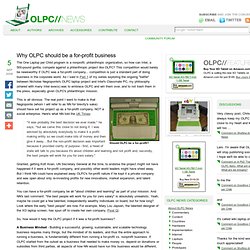

ICTs in Education: The “One Laptop Per Child” Program – Right Intentions but Flawed Approach. In 2005, Nicholas Negroponte, the founder of MIT’s Media Labs, announced the One Laptop per Child (OLPC) program at the World Economic Forum.

The concept was simple and appealing: Innovate a $100 laptop and distribute it to children in the developing world. No one can argue the power of getting kids access to computers/internet, and as a result, connectivity to the world and huge resource of information. But as the OLPC program has found out over the years, there is more to the success of Information and Communications Technologies (ICTs) in Education, than just handing out computers to kids, and expect it to works its magic on its own. For starters, the premises and approach of the OLPC program are fundamentally flawed. Some OLPC Statistics: - When OLPC was launched in 2005, it predicted the initial distribution of 100 to 150 million laptops by 2008 to targeted developing countries. The Main Issues with the OLPC program: 1) Affordability: 2) Flawed Expectations: 3) XO Design Issues:
Laptop With a Mission Widens Its Audience. Why OLPC should be a for-profit business. The One Laptop per Child program is a nonprofit, philanthropic organization, so how can Intel, a 500-pound gorilla, compete against a philanthropic project like OLPC?

This competition would barely be newsworthy if OLPC was a for-profit company... competition is just a standard part of doing business in the corporate world. As I said in Part 1 of my series exploring the ongoing "battle" between Nicholas Negroponte's OLPC laptop project and Intel's Classmate PC, my philosophy (shared with many Intel execs) was to embrace OLPC and win them over, and to not trash them in the press, especially given OLPC's philanthropic mission.
Should OLPC be a for-profit? This is all obvious. The real point I want to make is that Negroponte (whom I will refer to as NN for brevity's sake) should have set his project up as a for-profit company, NOT a social enterprise. "It was probably the best decision we ever made," he says, "but we came this close to not doing it. Ethiopia: Lack of funding collapsing OLPC - Yohanes. Even though it has been over a year since Ethiopia began implementing the 'One Laptop per Child' (OLPC), the program may not continue due to lack of funding.

The programme is said to have distributed some 5,000 laptop computers to children from second to eight grades in that country last year alone. Though the government of Ethiopia and the society have shown support to OPC’s implementation in Ethiopia, the furtherance of the program, which distributed 5,000 laptop computers to children from second to eight grades last year, is facing financial constraint. “In Ethiopia, we donated laptops because while the political will and grassroots support are strong, funding was an issue,” told Africa News, Matt Keller OLPC program Director for Europe, Middle East and Africa.
The 5,000 laptops were donated to the country as a result of the 2007 Give One, Get One promotion of OLPC. The total cost of the laptops including curriculum development and teachers’ training was 940,000 USD. OLPC Conception. Secret Origin of the OLPC: Genius, Hubris and the Birth of the Netbook.